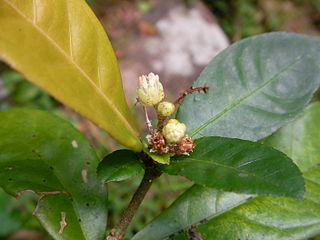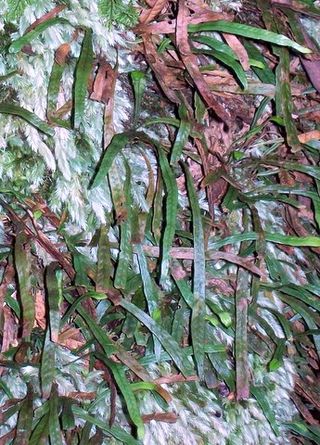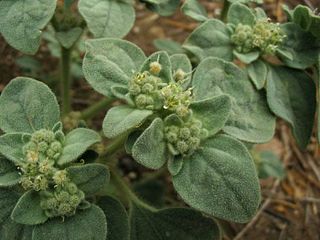
Dragon's blood is a bright red resin which is obtained from different species of a number of distinct plant genera: Calamus spp. also including Calamus rotang, Croton, Dracaena and Pterocarpus. The red resin has been in continuous use since ancient times as varnish, medicine, incense, pigment, and dye.

Croton is an extensive plant genus in the spurge family, Euphorbiaceae. The plants of this genus were described and introduced to Europeans by Georg Eberhard Rumphius. The common names for this genus are rushfoil and croton, but the latter also refers to Codiaeum variegatum. The generic name comes from the Greek κρότος, which means "tick" and refers to the shape of the seeds of certain species.

Croton hanceiBenth., the Hong Kong croton, is a shrub or small tree, a species of Croton which is endemic to Tsing Yi Island, Hong Kong. In Hong Kong, it is listed in the book Rare and precious Plants of Hong Kong.

Adenophorus is a genus of ferns in the family Polypodiaceae, subfamily Grammitidoideae, according to the Pteridophyte Phylogeny Group classification of 2016 (PPG I). The genus is endemic to Hawaii.

Codiaeum variegatum is a species of plant in the genus Codiaeum, which is a member of the family Euphorbiaceae. It was described by Carl Linnaeus in 1753. It is native to Indonesia, Malaysia, Australia, and the western Pacific Ocean islands, growing in open forests and scrub.

Grammitis is a genus of ferns in the family Polypodiaceae, subfamily Grammitidoideae, according to the Pteridophyte Phylogeny Group classification of 2016 (PPG I). It had formerly been placed in the family Grammitidaceae, but this family is no longer recognized by most authors because phylogenetic analyses of DNA sequences have shown that it is embedded in Polypodiaceae.

Croton setiger is a species of plant known in English as turkey mullein, dove weed, and fish locoweed. It is native to most of the western United States and northwest Mexico. It has naturalized elsewhere, including parts of Australia. It is sometimes spelled Croton setigerus and was formerly known as Eremocarpus setigerus.

The Jacqueline Kennedy Onassis Reservoir, also known as Central Park Reservoir, is a decommissioned reservoir in Central Park in the borough of Manhattan, New York City, stretching from 86th to 96th Streets. It covers 106 acres (43 ha) and holds over 1 billion US gal (3.8 million m3) of water.

Croton californicus is a species of croton known by the common name California croton. This plant is native to California, Nevada, Utah, Arizona, and Baja California, where it grows in the deserts and along the coastline.

Croton eluteria, known as cascarilla, is a plant species of the genus Croton that is native to the Caribbean. It has been naturalized in other tropical regions of the Americas. It grows to be a small tree or tall shrub, rarely reaching 20 feet (6 m) in height. Its leaves are scanty, alternate, ovate-lanceolate, averaging 2 inches (5 cm) long, with close scaling below, giving a metallic silver-bronze appearance, and scattered white scales above. The flowers are small, with white petals, and very fragrant, appearing in March and April. The scented bark is fissured, pale yellowish brown, and may be covered in lichen.

Croton tiglium, known as purging croton, is a plant species in the family Euphorbiaceae.

Adenophorus periens is a rare species of fern known by the common name pendant kihi fern. It is endemic to Hawaii, where it is known from one population in Puna on the island of Hawaii and a few occurrences on Kauai and Molokai. The fern occurs in wet mountain forests on volcanic slopes. It grows on trees. There are perhaps 2000 individual plants remaining. This is a federally listed endangered species of the United States.

Croton gratissimus, is a tropical African shrub or small tree with corky bark, growing to 8 m and belonging to the family of Euphorbiaceae or spurges. Young twigs are slender and angular and covered in silver and rust-coloured scales.

Croton glandulosus is a species of plant in the family Euphorbiaceae that has many common names such as vente conmigo, tooth-leaved croton, tropic croton and sand croton. The species's specific epithet, glandulosus, is due to the gland-like structures that appear at the end of the leaf stalk. C. glandulosus and various other species are found to be common weeds in gardens, crops, and lawns. This species in particular is highly problematic in crops such as cotton and peanuts in the Southeastern United States.

Croton monanthogynus is a species of flowering plant in the spurge family. The undersides are gray. It is a summer annual that produces small, inconspicuous flowers. The plant is monoecious and has both male and female reproductive organs in separate clusters on the same plant. Its leaves are alternate. It is native to the southeastern United States and the southern Great Plains. It is considered adventive in more northern states. AL, AR, AZ, GA, IA, IL, IN, KS, KY, LA, MD, MI, MO, MS, NC, NE, OH, OK, PA, SC, TN, TX, VA, WI, WV.
Rubus adenophorus is a species of deciduous shrub in the genus Rubus in the family Rosaceae native to China, where it was discovered in 1907. It is distinctive for its black-headed glands mixed with bristles on the stems.

Adenophorus tamariscinus, the wahine noho mauna, is a species of fern endemic to the US state of Hawaii.
Croton michauxii, commonly known as elliptical rushfoil, and Michaux's croton, is a plant species in the family Euphorbiaceae that is native to the United States. It is an annual plant.

Croton alabamensis var. texensis is a variety of Croton alabamensis that is endemic to the state of Texas in the United States. It is commonly known as the Texabama croton.
















